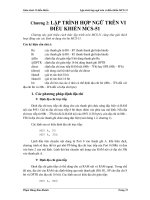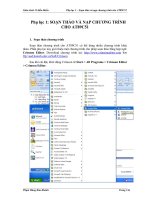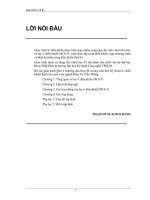Tài liệu Giáo trình Vi điều khiển - Phục lục 4 pdf
Bạn đang xem bản rút gọn của tài liệu. Xem và tải ngay bản đầy đủ của tài liệu tại đây (312.18 KB, 40 trang )
Giáo trình Vi điều khiển Phụ lục 4 – Mô tả tập lệnh
Phạm Hùng Kim Khánh Trang 195
Phụ lục 4: MÔ TẢ TẬP LỆNH
1. ACALL addr11
Function: Absolute Call
Description: ACALL unconditionally calls a subroutine located at the indicated
address. The instruction increments the PC twice to obtain the address of the
following instruction, then pushes the 16-bit result onto the stack (low-order byte first)
and increments the Stack Pointer twice. The destination address is obtained by
successively concatenating the five high-order bits of the incremented PC, opcode bits
7 through 5, and the second byte of the instruction. The subroutine called must
therefore start within the same 2 K block of the program memory as the first byte of
the instruction following ACALL. No flags are affected.
Example: Initially SP equals 07H. The label SUBRTN is at program memory location
0345 H. After executing the following instruction,
ACALL SUBRTN
at location 0123H, SP contains 09H, internal RAM locations 08H and 09H will
contain 25H and 01H, respectively, and the PC contains 0345H.
Bytes: 2
Cycles: 2
Encoding:
A10 A9 A8 1 0 001A7A6A5A4A3A2 A1 A0
Operation: ACALL
(PC) ← (PC) + 2
(SP) ← (SP) + 1
((SP)) ← (PC7-0)
(SP) ← (SP) + 1
((SP)) ← (PC15-8)
(PC10-0) ← page address
2. ADD A,<src-byte>
Function: Add
Description: ADD adds the byte variable indicated to the Accumulator, leaving the
result in the Accumulator. The carry and auxiliary-carry flags are set, respectively, if
there is a carry-out from bit 7 or bit 3, and cleared otherwise. When adding unsigned
integers, the carry flag indicates an overflow occurred.
OV is set if there is a carry-out of bit 6 but not out of bit 7, or a carry-out of bit 7 but
not bit 6; otherwise, OV is cleared. When adding signed integers, OV indicates a
negative number produced as the sum of two positive operands, or a positive sum
from two negative operands.
Four source operand addressing modes are allowed: register, direct, register-indirect,
or immediate.
Giáo trình Vi điều khiển Phụ lục 4 – Mô tả tập lệnh
Phạm Hùng Kim Khánh Trang 196
Example: The Accumulator holds 0C3H (1100001lB), and register 0 holds 0AAH
(10101010B). The following instruction,
ADD A,R0
leaves 6DH (01101101B) in the Accumulator with the AC flag cleared and both the
carry flag and OV set to 1.
2.1. ADD A,Rn
Bytes: 1
Cycles: 1
Encoding:
00101
r r r
Operation: ADD
(A) ← (A) + (Rn)
2.2. ADD A,direct
Bytes: 2
Cycles: 1
Encoding:
0 0 100101direct address
Operation: ADD
(A) ← (A) + (direct)
2.3. ADD A,@Ri
Bytes: 1
Cycles: 1
Encoding:
0010011i
Operation: ADD
(A) ← (A) + ((Ri))
2.4. ADD A,#data
Bytes: 2
Cycles: 1
Encoding:
0 0 1 0 0 1 0 0 immediate data
Operation: ADD
(A) ← (A) + #data
3. ADDC A, <src-byte>
Function: Add with Carry
Description: ADDC simultaneously adds the byte variable indicated, the carry flag
and the Accumulator contents, leaving the result in the Accumulator. The carry and
auxiliary-carry flags are set respectively, if there is a carry-out from bit 7 or bit 3, and
Giáo trình Vi điều khiển Phụ lục 4 – Mô tả tập lệnh
Phạm Hùng Kim Khánh Trang 197
cleared otherwise. When adding unsigned integers, the carry flag indicates an
overflow occurred.
OV is set if there is a carry-out of bit 6 but not out of bit 7, or a carry-out of bit 7 but
not out of bit 6; otherwise OV is cleared. When adding signed integers, OV indicates a
negative number produced as the sum of two positive operands or a positive sum from
two negative operands.
Four source operand addressing modes are allowed: register, direct, register-indirect,
or immediate.
Example: The Accumulator holds 0C3H (11000011B) and register 0 holds 0AAH
(10101010B) with the carry flag set. The following instruction,
ADDC A,R0
leaves 6EH (01101110B) in the Accumulator with AC cleared and both the Carry flag
and OV set to 1.
3.1. ADDC A,Rn
Bytes: 1
Cycles: 1
Encoding:
00111
r r r
Operation: ADDC
(A) ← (A) + (C) + (Rn)
3.2. ADDC A,direct
Bytes: 2
Cycles: 1
Encoding:
0 0 110101direct address
Operation: ADDC
(A) ← (A) + (C) + (direct)
3.3. ADDC A,@Ri
Bytes: 1
Cycles: 1
Encoding:
0011011i
Operation: ADDC
(A) ← (A) + (C) + ((Ri))
3.4. ADDC A,#data
Bytes: 2
Cycles: 1
Encoding:
0 0 1 1 0 1 0 0 immediate data
Giáo trình Vi điều khiển Phụ lục 4 – Mô tả tập lệnh
Phạm Hùng Kim Khánh Trang 198
Operation: ADDC
(A) ← (A) + (C) + #data
4. AJMP addr11
Function: Absolute Jump
Description: AJMP transfers program execution to the indicated address, which is
formed at run-time by concatenating the high-order five bits of the PC (after
incrementing the PC twice), opcode bits 7 through 5, and the second byte of the
instruction. The destination must therfore be within the same 2 K block of program
memory as the first byte of the instruction following AJMP.
Example: The label JMPADR is at program memory location 0123H. The following
instruction,
AJMP JMPADR
is at location 0345H and loads the PC with 0123H.
Bytes: 2
Cycles: 2
Encoding:
A10 A9 A8 0 0 001A7A6A5A4A3A2 A1 A0
Operation: AJMP
(PC) ← (PC) + 2
(PC10-0) ← page address
5. ANL<dest-byte>,<src-byte>
Function: Logical-AND for byte variables
Description: ANL performs the bitwise logical-AND operation between the variables
indicated and stores the results in the destination variable. No flags are affected.
The two operands allow six addressing mode combinations. When the destination is
the Accumulator, the source can use register, direct, register-indirect, or immediate
addressing; when the destination is a direct address, the source can be the
Accumulator or immediate data.
Note: When this instruction is used to modify an output port, the value used as the
original port data will be read from the output data latch, not the input pins.
Example: If the Accumulator holds 0C3H (1100001lB), and register 0 holds 55H
(01010101B), then the following instruction,
ANL A,R0
leaves 41H (01000001B) in the Accumulator.
When the destination is a directly addressed byte, this instruction clears combinations
of bits in any RAM location or hardware register. The mask byte determining the
pattern of bits to be cleared would either be a constant contained in the instruction or a
value computed in the Accumulator at run-time. The following instruction,
ANL P1,#01110011B
clears bits 7, 3, and 2 of output port 1.
5.1. ANL A,Rn
Giáo trình Vi điều khiển Phụ lục 4 – Mô tả tập lệnh
Phạm Hùng Kim Khánh Trang 199
Bytes: 1
Cycles: 1
Encoding:
01011
r r r
Operation: ANL
(A) ← (A) ∧ (Rn)
5.2. ANL A,direct
Bytes: 2
Cycles: 1
Encoding:
0 1 010101direct address
Operation: ANL
(A) ← (A) ∧ (direct)
5.3. ANL A,@Ri
Bytes: 1
Cycles: 1
Encoding:
0101011i
Operation: ANL
(A) ← (A) ∧ ((Ri))
5.4. ANL A,#data
Bytes: 2
Cycles: 1
Encoding:
0 1 0 1 0 1 0 0 immediate data
Operation: ANL
(A) ← (A) ∧ #data
5.5. ANL direct,A
Bytes: 2
Cycles: 1
Encoding:
0 1 010010direct address
Operation: ANL
(direct) ← (direct) ∧ (A)
5.6. ANL direct,#data
Bytes: 3
Cycles: 2
Encoding:
Giáo trình Vi điều khiển Phụ lục 4 – Mô tả tập lệnh
Phạm Hùng Kim Khánh Trang 200
0 1 0 1 0 0 1 1 direct address immediate data
Operation: ANL
(direct) ← (direct) ∧ #data
6. ANL C,<src-bit>
Function: Logical-AND for bit variables
Description: If the Boolean value of the source bit is a logical 0, then ANL C clears
the carry flag; otherwise, this instruction leaves the carry flag in its current state. A
slash ( / ) preceding the operand in the assembly language indicates that the logical
complement of the addressed bit is used as the source value, but the source bit itself is
not affected. No other flags are affected.
Only direct addressing is allowed for the source operand.
Example: Set the carry flag if, and only if, P1.0 = 1, ACC.7 = 1, and OV = 0:
MOV C,P1.0 ;LOAD CARRY WITH INPUT PIN STATE
ANL C,ACC.7 ;AND CARRY WITH ACCUM. BIT 7
ANL C,/OV ;AND WITH INVERSE OF OVERFLOW FLAG
6.1. ANL C,bit
Bytes: 2
Cycles: 2
Encoding:
1 0 000010
bit address
Operation: ANL
(C) ← (C) ∧ (bit)
6.2. ANL C,/bit
Bytes: 2
Cycles: 2
Encoding:
1 0 110000
bit address
Operation: ANL
(C) ← (C) ∧ NOT (bit)
7. CJNE <destbyte>,<src-byte>, rel
Function: Compare and Jump if Not Equal.
Description: CJNE compares the magnitudes of the first two operands and branches if
their values are not equal. The branch destination is computed by adding the signed
relative-displacement in the last instruction byte to the PC, after incrementing the PC
to the start of the next instruction. The carry flag is set if the unsigned integer value of
<dest-byte> is less than the unsigned integer value of <src-byte>; otherwise, the carry
is cleared. Neither operand is affected.
Giáo trình Vi điều khiển Phụ lục 4 – Mô tả tập lệnh
Phạm Hùng Kim Khánh Trang 201
The first two operands allow four addressing mode combinations: the Accumulator
may be compared with any directly addressed byte or immediate data, and any indirect
RAM location or working register can be compared with an immediate constant.
Example: The Accumulator contains 34H. Register 7 contains 56H. The first
instruction in the sequence,
CJNE R7, # 60H, NOT_EQ
; . . . . . . . . ;R7 = 60H.
NOT_EQ: JC REQ_LOW ;IF R7 < 60H.
; . . . . . . . . ;R7 > 60H.
sets the carry flag and branches to the instruction at label NOT_EQ. By testing the
carry flag, this instruction determines whether R7 is greater or less than 60H.
If the data being presented to Port 1 is also 34H, then the following instruction,
WAIT: CJNE A, P1,WAIT
clears the carry flag and continues with the next instruction in sequence, since the
Accumulator does equal the data read from P1. (If some other value was being input
on P1, the program loops at this point until the P1 data changes to 34H.)
7.1. CJNE A,direct,rel
Bytes: 3
Cycles: 2
Encoding:
1 0 1 1 0 1 0 1 direct address relative address
Operation: (PC) ← (PC) + 3
IF (A) < > (direct) THEN
(PC) ← (PC) + relative offset
IF (A) < (direct) THEN
(C) ← 1
ELSE
(C) ← 0
7.2. CJNE A,#data,rel
Bytes: 3
Cycles: 2
Encoding:
1 0 1 1 0 1 0 0 immediate data relative address
Operation: (PC) ← (PC) + 3
IF (A) < > data THEN
(PC) ← (PC) + relative offset
IF (A) < data THEN
(C) ← 1
ELSE
(C) ← 0
7.3. CJNE Rn,#data,rel
Giáo trình Vi điều khiển Phụ lục 4 – Mô tả tập lệnh
Phạm Hùng Kim Khánh Trang 202
Bytes: 3
Cycles: 2
Encoding:
1 0 1 1 1
r r r immediate data relative address
Operation: (PC) ← (PC) + 3
IF (Rn) < > data THEN
(PC) ← (PC) + relative offset
IF (Rn) < data THEN
(C) ← 1
ELSE
(C) ← 0
7.4. CJNE @Ri,data,rel
Bytes: 3
Cycles: 2
Encoding:
1 0 1 1 0 1 1 i immediate data relative address
Operation: (PC) ← (PC) + 3
IF ((Ri)) < > data THEN
(PC) ← (PC) + relative offset
IF ((Ri)) < data THEN
(C) ← 1
ELSE
(C) ← 0
8. CLR A
Function: Clear Accumulator
Description: CLR A clears the Accumulator (all bits set to 0). No flags are affected
Example: The Accumulator contains 5CH (01011100B). The following instruction,
CLR A
leaves the Accumulator set to 00H (00000000B).
Bytes: 1
Cycles: 1
Encoding:
11100100
Operation: CLR
(A) ← 0
9. CLR bit
Function: Clear bit
Description: CLR bit clears the indicated bit (reset to 0). No other flags are affected.
CLR can operate on the carry flag or any directly addressable bit.
Giáo trình Vi điều khiển Phụ lục 4 – Mô tả tập lệnh
Phạm Hùng Kim Khánh Trang 203
Example: Port 1 has previously been written with 5DH (01011101B). The following
instruction,
CLR P1.2
leaves the port set to 59H (01011001B).
9.1. CLR C
Bytes: 1
Cycles: 1
Encoding:
11000011
Operation: CLR
(C) ← 0
9.2. CLR bit
Bytes: 2
Cycles: 1
Encoding:
1 1 0 0 0 0 1 0 bit address
Operation: CLR
(bit) ← 0
10. CPL A
Function: Complement Accumulator
Description: CPLA logically complements each bit of the Accumulator (one’s
complement). Bits which previously contained a 1 are changed to a 0 and vice-versa.
No flags are affected.
Example: The Accumulator contains 5CH (01011100B). The following instruction,
CPL A
leaves the Accumulator set to 0A3H (10100011B).
Bytes: 1
Cycles: 1
Encoding:
11110100
Operation: CPL
(A) ← NOT (A)
11. CPL bit
Function: Complement bit
Description: CPL bit complements the bit variable specified. A bit that had been a 1
is changed to 0 and vice-versa. No other flags are affected. CLR can operate on the
carry or any directly addressable bit.
Note: When this instruction is used to modify an output pin, the value used as the
original data is read from the output data latch, not the input pin.
Giáo trình Vi điều khiển Phụ lục 4 – Mô tả tập lệnh
Phạm Hùng Kim Khánh Trang 204
Example: Port 1 has previously been written with 5BH (01011101B). The following
instruction sequence,
CPL P1.1
CPL P1.2
leaves the port set to 5BH (01011011B).
11.1. CPL C
Bytes: 1
Cycles: 1
Encoding:
10110011
1 0 1 1 0 0 1 1
Operation: CPL
(C) ← NOT (C)
11.2. CPL bit
Bytes: 2
Cycles: 1
Encoding:
1 0 110010
bit address
Operation: CPL
(bit) ← NOT (bit)
12. DA A
Function: Decimal-adjust Accumulator for Addition
Description: DA A adjusts the eight-bit value in the Accumulator resulting from the
earlier addition of two variables (each in packed-BCD format), producing two four-bit
digits. Any ADD or ADDC instruction may have been used to perform the addition.
If Accumulator bits 3 through 0 are greater than nine (xxxx1010-xxxx1111), or if the
AC flag is one, six is added to the Accumulator producing the proper BCD digit in the
low-order nibble. This internal addition sets the carry flag if a carry-out of the low-
order four-bit field propagates through all high-order bits, but it does not clear the
carry flag otherwise.
If the carry flag is now set, or if the four high-order bits now exceed nine (1010xxxx-
1111xxxx), these high-order bits are incremented by six, producing the proper BCD
digit in the high-order nibble. Again, this sets the carry flag if there is a carry-out of
the high-order bits, but does not clear the carry. The carry flag thus indicates if the
sum of the original two BCD variables is greater than 100, allowing multiple precision
decimal addition. OV is not affected.
All of this occurs during the one instruction cycle. Essentially, this instruction
performs the decimal conversion by adding 00H, 06H, 60H, or 66H to the
Accumulator, depending on initial Accumulator and PSW conditions.
Note: DA A cannot simply convert a hexadecimal number in the Accumulator to BCD
notation, nor does DA A apply to decimal subtraction.
Giáo trình Vi điều khiển Phụ lục 4 – Mô tả tập lệnh
Phạm Hùng Kim Khánh Trang 205
Example: The Accumulator holds the value 56H (01010110B), representing the
packed BCD digits of the decimal number 56. Register 3 contains the value 67H
(01100111B), representing the packed BCD digits of the decimal number 67. The
carry flag is set. The following instruction sequence
ADDC A,R3
DA A
first performs a standard two’s-complement binary addition, resulting in the value
0BEH (10111110) in the Accumulator. The carry and auxiliary carry flags are cleared.
The Decimal Adjust instruction then alters the Accumulator to the value 24H
(00100100B), indicating the packed BCD digits of the decimal number 24, the low-
order two digits of the decimal sum of 56, 67, and the carry-in. The carry flag is set by
the Decimal Adjust instruction, indicating that a decimal overflow occurred. The true
sum of 56, 67, and 1 is 124.
BCD variables can be incremented or decremented by adding 01H or 99H. If the
Accumulator initially holds 30H (representing the digits of 30 decimal), then the
following instruction sequence,
ADD A, # 99H
DA A
leaves the carry set and 29H in the Accumulator, since 30 + 99 = 129. The low-order
byte of the sum can be interpreted to mean 30 - 1 = 29.
Bytes: 1
Cycles: 1
Encoding:
11010100
Operation: DA
-contents of Accumulator are BCD
IF [[(A3-0) > 9] ∨ [(AC) = 1]] THEN (A3-0) ← (A3-0) + 6
AND
IF [[(A7-4) > 9] ∨ [(C) = 1]] THEN (A7-4) ← (A7-4) + 6
13. DEC byte
Function: Decrement
Description: DEC byte decrements the variable indicated by 1. An original value of
00H underflows to 0FFH. No flags are affected. Four operand addressing modes are
allowed: accumulator, register, direct, or register-indirect.
Note: When this instruction is used to modify an output port, the value used as the
original port data will be read from the output data latch, not the input pins.
Example: Register 0 contains 7FH (01111111B). Internal RAM locations 7EH and
7FH contain 00H and 40H, respectively.
The following instruction sequence,
DEC @R0
DEC R0
DEC @R0
leaves register 0 set to 7EH and internal RAM locations 7EH and 7FH set to 0FFH
and 3FH.
Giáo trình Vi điều khiển Phụ lục 4 – Mô tả tập lệnh
Phạm Hùng Kim Khánh Trang 206
13.1. DEC A
Bytes: 1
Cycles: 1
Encoding:
00010100
Operation: DEC
(A) ← (A) - 1
13.2. DEC Rn
Bytes: 1
Cycles: 1
Encoding:
00011
r r r
Operation: DEC
(Rn) ← (Rn) - 1
13.3. DEC direct
Bytes: 2
Cycles: 1
Encoding:
0 0 010101direct address
Operation: DEC
(direct) ← (direct) - 1
13.4. DEC @Ri
Bytes: 1
Cycles: 1
Encoding:
0001011i
Operation: DEC
((Ri)) ← ((Ri)) - 1
14. DIV AB
Function: Divide
Description: DIV AB divides the unsigned eight-bit integer in the Accumulator by
the unsigned eight-bit integer in register B.
The Accumulator receives the integer part of the quotient; register B receives the
integer remainder. The carry and OV flags are cleared.
Exception: if B had originally contained 00H, the values returned in the Accumulator
and B-register are undefined and the overflow flag are set. The carry flag is cleared in
any case.
Example: The Accumulator contains 251 (0FBH or 11111011B) and B contains 18
(12H or 00010010B). The following instruction,
Giáo trình Vi điều khiển Phụ lục 4 – Mô tả tập lệnh
Phạm Hùng Kim Khánh Trang 207
DIV AB
leaves 13 in the Accumulator (0DH or 00001101B) and the value 17 (11H or
00010001B) in B, since 251 = (13 x 18) + 17. Carry and OV are both cleared.
Bytes: 1
Cycles: 4
Encoding:
10000100
Operation: DIV
(A)
15-8
← (A)/(B)
(B)
7-0
15. DJNZ <byte>,<rel addr>
Function: Decrement and Jump if Not Zero
Description: DJNZ decrements the location indicated by 1, and branches to the
address indicated by the second operand if the resulting value is not zero. An original
value of 00H underflows to 0FFH. No flags are affected. The branch destination is
computed by adding the signed relative-displacement value in the last instruction byte
to the PC, after incrementing the PC to the first byte of the following instruction. The
location decremented may be a register or directly addressed byte.
Note: When this instruction is used to modify an output port, the value used as the
original port data will be read from the output data latch, not the input pins.
Example: Internal RAM locations 40H, 50H, and 60H contain the values 01H, 70H,
and 15H, respectively. The following instruction sequence,
DJNZ 40H,LABEL_1
DJNZ 50H,LABEL_2
DJNZ 60H,LABEL_3
causes a jump to the instruction at label LABEL_2 with the values 00H, 6FH, and
15H in the three RAM locations. The first jump was not taken because the result was
zero.
This instruction provides a simple way to execute a program loop a given number of
times or for adding a moderate time delay (from 2 to 512 machine cycles) with a
single instruction. The following instruction sequence,
MOV R2, # 8
TOGGLE: CPL P1.7
DJNZ R2,TOGGLE
toggles P1.7 eight times, causing four output pulses to appear at bit 7 of output Port 1.
Each pulse lasts three machine cycles; two for DJNZ and one to alter the pin.
15.1. DJNZ Rn,rel
Bytes: 2
Cycles: 2
Encoding:
1 1 0 1 1
r r r relative address
Operation: DJNZ
Giáo trình Vi điều khiển Phụ lục 4 – Mô tả tập lệnh
Phạm Hùng Kim Khánh Trang 208
(PC) ← (PC) + 2
(Rn) ← (Rn) - 1
IF (Rn) > 0 or (Rn) < 0 THEN
(PC) ← (PC) + rel
15.2. DJNZ direct,rel
Bytes: 3
Cycles: 2
Encoding:
1 1 0 1 0 1 0 1 direct add
ress relative address
Operation: DJNZ
(PC) ← (PC) + 2
(direct) ← (direct) - 1
IF (direct) > 0 or (direct) < 0 THEN
(PC) ← (PC) + rel
16. INC <byte>
Function: Increment
Description: INC increments the indicated variable by 1. An original value of 0FFH
overflows to 00H. No flags are affected.
Three addressing modes are allowed: register, direct, or register-indirect.
Note: When this instruction is used to modify an output port, the value used as the
original port data will be read from the output data latch, not the input pins.
Example: Register 0 contains 7EH (011111110B). Internal RAM locations 7EH and
7FH contain 0FFH and 40H, respectively. The following instruction sequence,
INC @R0
INC R0
INC @R0
leaves register 0 set to 7FH and internal RAM locations 7EH and 7FH holding 00H
and 41H, respectively.
16.1. INC A
Bytes: 1
Cycles: 1
Encoding:
00000100
Operation: INC
(A) ← (A) + 1
16.2. INC Rn
Bytes: 1
Cycles: 1
Encoding:
Giáo trình Vi điều khiển Phụ lục 4 – Mô tả tập lệnh
Phạm Hùng Kim Khánh Trang 209
00001r r r
Operation: INC
(Rn) ← (Rn) + 1
16.3. INC direct
Bytes: 2
Cycles: 1
Encoding:
0 0 0 00101direct address
Operation: INC
(direct) ← (direct) + 1
16.4. INC @Ri
Bytes: 1
Cycles: 1
Encoding:
0000011i
Operation: INC
((Ri)) ← ((Ri)) + 1
17. INC DPTR
Function: Increment Data Pointer
Description: INC DPTR increments the 16-bit data pointer by 1. A 16-bit increment
(modulo 216) is performed, and an overflow of the low-order byte of the data pointer
(DPL) from 0FFH to 00H increments the high-order byte (DPH). No flags are
affected. This is the only 16-bit register which can be incremented.
Example: Registers DPH and DPL contain 12H and 0FEH, respectively. The
following instruction sequence,
INC DPTR
INC DPTR
INC DPTR
changes DPH and DPL to 13H and 01H.
Bytes: 1
Cycles: 2
Encoding:
10100011
Operation: INC
(DPTR) ← (DPTR) + 1
18. JB bit,rel
Function: Jump if Bit set
Description: If the indicated bit is a one, JB jump to the address indicated; otherwise,
it proceeds with the next instruction. The branch destination is computed by adding
Giáo trình Vi điều khiển Phụ lục 4 – Mô tả tập lệnh
Phạm Hùng Kim Khánh Trang 210
the signed relative-displacement in the third instruction byte to the PC, after
incrementing the PC to the first byte of the next instruction. The bit tested is not
modified. No flags are affected.
Example: The data present at input port 1 is 11001010B. The Accumulator holds 56
(01010110B). The following instruction sequence,
JB P1.2,LABEL1
JB ACC. 2,LABEL2
causes program execution to branch to the instruction at label LABEL2.
Bytes: 3
Cycles: 2
Encoding:
0 0 1 0 0 0 0 0
bit address relative address
Operation: JB
(PC) ← (PC) + 3
IF (bit) = 1 THEN
(PC) ← (PC) + rel
19. JBC bit,rel
Function: Jump if Bit is set and Clear bit
Description: If the indicated bit is one, JBC branches to the address indicated;
otherwise, it proceeds with the next instruction. The bit will not be cleared if it is
already a zero. The branch destination is computed by adding the signed relative-
displacement in the third instruction byte to the PC, after incrementing the PC to the
first byte of the next instruction. No flags are affected.
Note: When this instruction is used to test an output pin, the value used as the original
data will be read from the output data latch, not the input pin.
Example: The Accumulator holds 56H (01010110B). The following instruction
sequence,
JBC ACC.3,LABEL1
JBC ACC.2,LABEL2
causes program execution to continue at the instruction identified by the label
LABEL2, with the Accumulator modified to 52H (01010010B).
Bytes: 3
Cycles: 2
Encoding:
0 0 0 1 0 0 0 0 bit address relative address
Operation: JBC
(PC) ← (PC) + 3
IF (bit) = 1 THEN
(bit) ← 0
(PC) ← (PC) +rel
20. JC rel
Function: Jump if Carry is set









